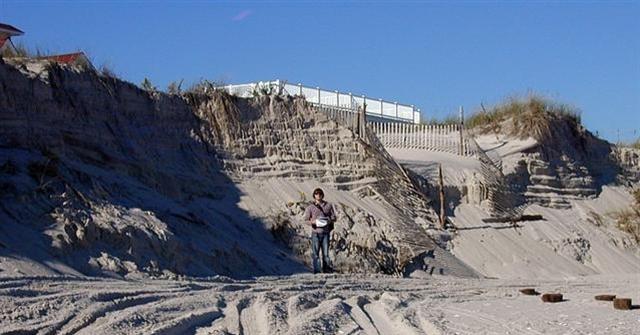State Wide Beach-Dune Assessment
The Stockton University Coastal Research Center has been awarded two Congressional Earmarks in the past two years to perform a statewide dune assessment of New Jersey's beaches. Starting in 2006, a GIS-based beach-dune system susceptibility assessment was undertaken to evaluate the performance of the oceanfront beach-dune system against storm events. The assessment integrates various types of spatial data and the USACE’s storm simulation model, SBEACH to identify weaknesses in the system and highlight areas that may be vulnerable to storm damage (such as erosion, over wash, or breach). The first assessment analyzes the integrity of the beach-dune system, long-shore from Manasquan Inlet to Barnegat Inlet (~23 miles). SBEACH storm simulations were ran for 2-year, 5-year, 10-year, 20-year, 50-year, and 100-year storm events using storm parameters developed by FEMA. The results of the erosion simulations were organized in a Geographic Information System to illustrate vulnerable regions of the beach-dune system. The next assessment will be the area between Barnegat Inlet and Little Egg Inlet. This assessment will be carried out in a similar manner, but will incorporate new techniques that we have developed in the first assessment. The beach-dune system of the northern Ocean County barrier-spit is a vital natural resource that protects shore communities against storm damage. Assessments of the beach-dune system are important for effective management and sustainability of this coastal zone resource. Assessments facilitate more efficient use of limited State and municipal resources by optimizing storm hazard mitigation activities. An assessment can be used to:
- Highlight potential problem spots in the beach-dune system
- Make more effective and efficient use of taxpayer money and municipal resources by focusing dune maintenance and enhancement activities in areas of need
- Improve protection of beach-front homes and back-beach properties
- Evaluate the effectiveness of previous maintenance and enhancement efforts
- Aid in the enforcement of dune and shore-zone ordinances and regulations
- Aid in emergency and rapid-response planning using the foreknowledge of where dunes are more likely to fail from stronger than normal storm activity
- Preserve a beach and dune environment that is aesthetically appealing to beach-goers



